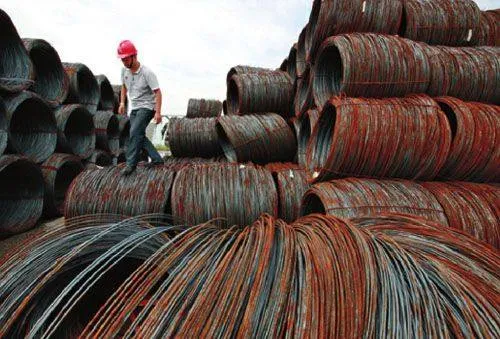Trimming the Excess
BBMG Corp. is a large cement producer listed on China’s stock market. Two of its subsidiaries are being eliminated because the Ministry of Industry and Information Technology (MIIT) has deemed their capacity excessive.
“We will, in accordance with the MIIT’s requirements, pull down the two subsidies by the end of September. The eliminated capacity only accounts for a small proportion of the corporation’s total capacity, therefore the performance of the corporation will not be affected,” said a BBMG statement.
According to its 2013 semi-annual report, BBMG now has a cement production capacity of 45 million tons, while each of the two subsidies to be shut down only has 100,000 tons of production capacity.
The MIIT publicized on July 25 a list of companies at overcapacity to be shut down, including 1,294 enterprises in 19 industries. The ministry ordered the closures by the end of September and said production should not be transferred to other regions.
Industries such as cement, steel, electrolytic aluminum, ferroalloy, copper smelting, chemical fiber and papermaking are among those required to cut surplus capacity. Altogether 527 enterprises in the cement industry are on the list. Alcohol, gourmet powder, citric acid and lead-acid battery were previously not key sectors of excess capacity but have now been included on the list.
China has been shutting down companies in overcapacity for a decade. When the plan began in 2003, only three industries were targeted—steel, cement and electrolytic aluminum. Today the list is five times longer.
Wang Yong, a researcher with CITIC Securities Co. Ltd., said announcing the list of enterprises to be shut down shows the government’s resolve to reduce excess capacity.
Although the Chinese Government has made several attempts to tackle the problem of overcapacity in the past, it had little success, said Wang. This time might be some different because the new term of government is keen on advancing economic reforms and tolerating slower economic growth.
Upgrading industry
“Among all the problems the Chinese economy is facing, overcapacity is at the top,” says Wang.“In some industries the problem has been quite serious, causing low prices and reducing the profits of enterprises,” Wang said.
Take the cement industry for example. It has been a key sector in the government’s past efforts to eliminate overcapacity. But production has not slowed. In 2009 capacity stood at 800 million tons, but at the end of 2012 the figure rose to 2.9 billion tons, with 75 percent actually being used.
Owing to the overcapacity and intensified competition among companies in excess capacity, the 25 listed cement companies, including BBMG, are suffering profit declines. Some of them even partially suspended production because of huge losses.
Industries including steel, electrolytic aluminum, flat glass and shipbuilding are also facing serious excess capacity. At the end of 2012 the utilization rates of the four industries were only 72 percent, 71.9 percent, 73.1 percent and 75 percent, respectively—far lower than international averages.
“Excess capacity reflects the structural problems in China that emerged during its industrialization,” says Wang.
Lu Zhengwei, chief economist with Industrial Bank Co. Ltd., said the Chinese Government is changing its pursuit of economic growth away from speed and scale and more toward quality production. The government hopes various industries can move toward sound and sustainable development through the creation of products of high added value.
However, surplus capacity is dampening the enthusiasm of enterprises to change their growth models, which has become a serious challenge for China.
Lu said the new government can tolerate an economic slowdown that may result due to shutting down companies with excess capacity. The shutdown of these companies may curb growth in the already sluggish manufacturing industries, but Lu believes the Central Government will not launch a new stimulus package as long as the economic growth does not fall below 7.5 percent.
Role of the market
Zhang Qianrong, a researcher with the Economic Forecast Department of the State Information Center, said the problem of surplus capacity extends from traditional industries to emerging industries such as the photovoltaic industry. Moreover, surplus capacity is of structural and systemic characteristics, therefore solving the problem isn’t so easy.
According to Zhang, the MIIT’s order this time combines industrial, fiscal, land and environmental protection policies to reduce excess capacity. All these policies can be effective to some extent to curb blind expansion of the involved industries, but these policies could only be stopgap measures without the cooperation of the market.
Zhang said whether the government orders the shutdown of excess capacity with laws and regulations or encourages shutdowns with credit, tax or price incentives, the point is to let the market decide resource allocation.
That means limiting the impulse of local governments to spend on big and wasteful projects. Zhang said one way to curb overspending is to change the way officials are evaluated for their performance. Local officials are evaluated based on GDP growth, which nudges them toward blind investment projects.
When reforming the assessment system, China should also improve how it distributes tax revenue for spending between central and local governments. Tightening the purse strings would ultimately result in a weaker impulse for investment. The means by which the Central Government allocates subsidies, tax refunds and concessional loans should be transparent to the public.

“Letting the market play its role and leaving the government to build and protect market rules will create an environment for fair competition, trim overcapacity and advance the upgrading of the country’s industrial structure,” Zhang said.
He said the government should adopt different measures in tackling different types of overcapacity. To the enterprises with outdated technologies, small scales or illegal production, the government should close them down in accordance with state laws and regulations and prevent them from resuming production when market demand and prices rise. For those industries with lowquality excess capacity caused by industrial structural problems, the government should support the development of high-quality capacity and eliminate poor-quality through credit, tax and price policies. Finally, for those with overcapacity caused by low purchasing power and inadequate effective demand, the government should guide enterprises toward more advanced technologies to create more high-end goods.
Lu said the ultimate way to eliminate outdated capacity is through market competition. The government mainly uses administrative measures to eliminate excess capacity, making a list and timetable for shutdowns and ordering local governments to follow through. But under the pressure of maintaining GDP growth and ensuring employment, some local governments scoff at the idea.
“The government has been tackling overcapacity for years, but the situation in some industries has not significantly changed,” said Lu. “Without involving the market, we won’t see a decrease in capacity. The ultimate way to eliminate outdated capacity is to let the market do its job.”

